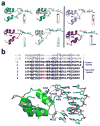TAL effectors: function, structure, engineering and applications
- PMID: 23265998
- PMCID: PMC3572262
- DOI: 10.1016/j.sbi.2012.11.001
TAL effectors: function, structure, engineering and applications
Abstract
TAL effectors are proteins secreted by bacterial pathogens into plant cells, where they enter the nucleus and activate expression of individual genes. TAL effectors display a modular architecture that includes a central DNA-binding region comprising a tandem array of nearly identical repeats that are almost all 34 residues long. Residue number 13 in each TAL repeat (one of two consecutive polymorphic amino acids that are termed 'repeat variable diresidues', or 'RVDs') specifies the identity of a single base; collectively the sequential repeats and their RVDs dictate the recognition of sequential bases along one of the two DNA strands. The modular architecture of TAL effectors has facilitated their extremely rapid development and application as artificial gene targeting reagents, particularly in the form of site-specific nucleases. Recent crystallographic and biochemical analyses of TAL effectors have established the structural basis of their DNA recognition properties and provide clear directions for future research.
Copyright © 2012 Elsevier Ltd. All rights reserved.
Figures



Similar articles
-
The crystal structure of TAL effector PthXo1 bound to its DNA target.Science. 2012 Feb 10;335(6069):716-9. doi: 10.1126/science.1216211. Epub 2012 Jan 5. Science. 2012. PMID: 22223736 Free PMC article.
-
Breaking the code of DNA binding specificity of TAL-type III effectors.Science. 2009 Dec 11;326(5959):1509-12. doi: 10.1126/science.1178811. Science. 2009. PMID: 19933107
-
Structural basis for sequence-specific recognition of DNA by TAL effectors.Science. 2012 Feb 10;335(6069):720-3. doi: 10.1126/science.1215670. Epub 2012 Jan 5. Science. 2012. PMID: 22223738 Free PMC article.
-
[Molecular recognition code between pathogenic bacterial TAL-effectors and host target genes: a review].Sheng Wu Gong Cheng Xue Bao. 2011 Aug;27(8):1132-41. Sheng Wu Gong Cheng Xue Bao. 2011. PMID: 22097801 Review. Chinese.
-
Engineering plant disease resistance based on TAL effectors.Annu Rev Phytopathol. 2013;51:383-406. doi: 10.1146/annurev-phyto-082712-102255. Annu Rev Phytopathol. 2013. PMID: 23725472 Review.
Cited by
-
Modulation of Plant Defense System in Response to Microbial Interactions.Front Microbiol. 2020 Jul 3;11:1298. doi: 10.3389/fmicb.2020.01298. eCollection 2020. Front Microbiol. 2020. PMID: 32719660 Free PMC article. Review.
-
Homologues of CsLOB1 in citrus function as disease susceptibility genes in citrus canker.Mol Plant Pathol. 2017 Aug;18(6):798-810. doi: 10.1111/mpp.12441. Epub 2016 Aug 11. Mol Plant Pathol. 2017. PMID: 27276658 Free PMC article.
-
TALE-Like Effectors Are an Ancestral Feature of the Ralstonia solanacearum Species Complex and Converge in DNA Targeting Specificity.Front Plant Sci. 2016 Aug 17;7:1225. doi: 10.3389/fpls.2016.01225. eCollection 2016. Front Plant Sci. 2016. PMID: 27582755 Free PMC article.
-
A CRISPR way for accelerating cereal crop improvement: Progress and challenges.Front Genet. 2023 Jan 6;13:866976. doi: 10.3389/fgene.2022.866976. eCollection 2022. Front Genet. 2023. PMID: 36685816 Free PMC article. Review.
-
New and TALENted genome engineering toolbox.Circ Res. 2013 Aug 16;113(5):571-87. doi: 10.1161/CIRCRESAHA.113.301765. Circ Res. 2013. PMID: 23948583 Free PMC article. Review.
References
-
- Boch J, Bonas U. Xanthomonas AvrBs3 family-type III effectors: discovery and function. Annu Rev Phytopathol. 2010;48:419–436. - PubMed
-
- Bogdanove AJ, Schornack S, Lahaye T. TAL effectors: finding plant genes for disease and defense. Curr Opin Plant Biol. 2010;13:394–401. - PubMed
-
- Bonas U, Stall RE, Staskawicz B. Genetic and structural characterization of the avirulence gene avrBs3 from Xanthomonas campestris pv. vesicatoria. Mol Gen Genet. 1989;218:127–136. - PubMed
Publication types
MeSH terms
Substances
Grants and funding
LinkOut - more resources
Full Text Sources
Other Literature Sources
Miscellaneous

